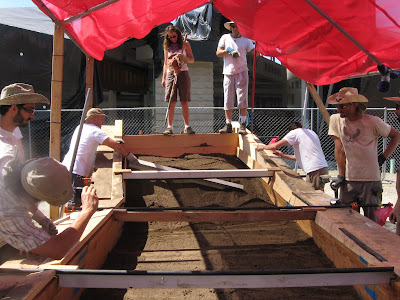Two house finches are eating the flowers on my Thai basil.
In other news, it took a hummingbird 8 minutes to notice that the feeder was re-filled.
Tuesday, August 21, 2012
rammed earth process
mixing: pre-sifted soil, cement, and water. We mixed partly by hand but mostly with a rototiller. Percentage of cement for this project ranged from %6-20. To check if there is enough water in the mix, form a ball of soil, drop it from about five feet: if it shatters completely, the moisture content is correct. However, it was so hot and dry, that we needed to add more water to compensate for the moisture that would evaporate during transport and ramming.
wheeling: find Sonia!
raking: distributing the soil mix evenly in the formwork
screeding: levelling the soil mix
ramming: we used manual (not electric) rammers, long metal poles with a small metal square at the end. The small surface area increases the pressure per square inch. It took a lot of strength to repeat this motion. Ramming decreases the soil volume to %60 of the original, and results in a very durable material. We added soil and rammed in layers or "lifts," I think there were 4-5 lifts total. These layers will likely be visible in the finished product, similar to the layers of sedimentary rock. In fact, some people described this process as turning soil back into rock.
wheeling: find Sonia!
raking: distributing the soil mix evenly in the formwork
screeding: levelling the soil mix
ramming: we used manual (not electric) rammers, long metal poles with a small metal square at the end. The small surface area increases the pressure per square inch. It took a lot of strength to repeat this motion. Ramming decreases the soil volume to %60 of the original, and results in a very durable material. We added soil and rammed in layers or "lifts," I think there were 4-5 lifts total. These layers will likely be visible in the finished product, similar to the layers of sedimentary rock. In fact, some people described this process as turning soil back into rock.
Monday, August 20, 2012
spiky, crusty, sword-like, and radial
a dried Yucca whipplei with dried flower stalk:
crustose lichen:
a bunch of yucca:
unidentified purple wildflower:
crustose lichen:
a bunch of yucca:
unidentified purple wildflower:
yellow, tan, silver, green + red
This past weekend I participated in a rammed earth workshop at Vasquez Rocks, led by Materials and Applications and Scrubjay Studios.
During the 50-minute drive from downtown LA, we passed through the San Gabriel Mountains, climbed and descended, and found ourselves in a hot, dry, rocky landscape with a distinctive color palette and plant community.
The plants of this woodland juniper community were stunning in the morning sun. I think the silvery shrub is ashyleaf buckwheat, contrasting here with the reddish dried flowers of California buckwheat:
California sagebrush with California buckwheat:
What might be ashyleaf buckwheat contrasting with warm yellow grass:
Tuesday, August 14, 2012
summer rewind: Griffith Park Observatory
It is a treat to live near the eastern end of enormous Griffith Park, not far from the Observatory and its wonderful views over the city. Whenever we have visitors, we are sure to take them to this spot. From here we can see people, like little ants, walking the Park's trails in the foreground, and in the background, all the way from downtown (as in this photo) to the Hollywood Hills and beyond.
Our friends Andrew and Carianne
The city grid was especially visible when lit up on the night of July 4th. To the west, we saw fireworks over the Hollywood Bowl.
Our friends Andrew and Carianne
The city grid was especially visible when lit up on the night of July 4th. To the west, we saw fireworks over the Hollywood Bowl.
Subscribe to:
Posts (Atom)


















